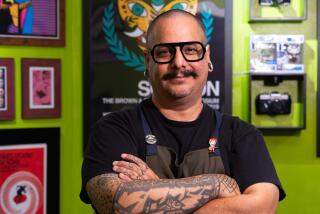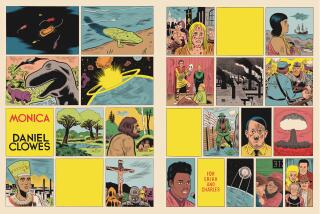CARTOONIST ARAGONES IS MAD ABOUT HIS WORK
- Share via
The baby boomers who grew up laughing at Sergio Aragones’ cartoons in Mad magazine have married and settled down, but their children are growing up laughing at the misadventures of Groo, the thick-witted hero of his monthly comic book.
Both generations of fans will be on hand at the Convention and Performing Arts Center tonight at 5 p.m. to hear Aragones speak--and watch him draw--as part of the San Diego Comic-Con, a four-day celebration of cartoons, comic books and fantasy films.
“I don’t remember not drawing, and I don’t remember starting to draw,” he said from his home-studio in Ojai. “If my family wanted to keep me entertained, they just gave me paper and a pencil--I’d sit quietly for hours. We could visit someone’s house all day long, and it would make no difference to me--I’d just sit and draw.”
Aragones still sits and draws. Even during an interview, he constantly doodles with a fine-tipped black marker, covering sheets of paper with simple, outline figures that range from a snail mistakenly falling in love with a Scotch tape dispenser to the familiar profile of Groo, with his prominent, broken nose.
Born in Castellon, Spain, in 1937, Aragones grew up in Mexico, as the Spanish Civil War forced his parents to flee as political refugees six months after he was born. At 16, he sold his first cartoons to the humor magazine Manana, but only learned of the sale after the fact: The editor of his high school newspaper had taken some cartoons he had done for her to the magazine without telling him.
“She took the whole staff to lunch with the money,” he recalled gleefully. “She announced, ‘It’s all on Sergio!’ I said I didn’t have enough money, and she replied, ‘Yes, you do. You just sold some cartoons to Manana.’ ”
Aragones continued to sell cartoons to various magazines during high school and college. But he came from an educated family, and his parents expected to earn a degree and enter a profession.
“Then, as always, you measured the quality of a career by economic success,” he said. “If you become a cartoonist, you’ll be poor all your life. So I studied architecture, but I never intended to be an architect. I spent most of my time cartooning--by then I had a weekly page in Manana.”
Although few young cartoonists have an entire page devoted to their work in a major magazine, Aragones seemed to be fulfilling his prediction about a cartoonist being poor all his life. During the early ‘60s, he earned the equivalent of about $8 per week from Manana.
“I did a lot of cartoons to supplement that $8,” he said with a laugh. “I’d do a little advertising work, or a cover for another magazine. I’d draw cartoons for a barber to put in his window to get a free haircut, or I’d do some cartoons about a sale for a store window to get a discount.”
In 1962, Aragones came to New York “with no money and a very full portfolio,” hoping to break into the more lucrative U.S. free-lance market. But American editors preferred cartoons that relied on printed captions for their humor; Aragones drew silent cartoons that got laughs through mime and body language.
“It’s not that I have anything against words,” he explained. “But I’ve always been impressed with mime, both in the theater and in cartoons. The American taste in humor is based on the British: It’s the punch lines, the words and the puns that make American humor what it is. There have been a few pantomime cartoons, like ‘Henry,’ but it’s not perceived as a relevant style of humor.
“And there are no gag cartoon magazines in America, as there are in the rest of the world. Here, cartoons are used as a filler or a freebie: If you’re an intellectual, you get them in New Yorker; if you like girls, you get them in Playboy. Nobody takes a magazine for the cartoons.”
Although no editors would buy his work, many were impressed with his talent and suggested he try Mad, which had a reputation for using unconventional styles of humor. While Aragones was visiting the exiled Cuban artist Antonio Prohias (“Spy vs. Spy”), at the magazine, the editors looked through his portfolio and promptly offered to buy a series of cartoons about astronauts.
Aragones soon became one of Mad’s most popular and prolific artists: His work has appeared in every issue for the last 25 years, and has been collected in several paperbacks.
During the late ‘60s, Aragones began writing for DC comics, doing stories for House of Mystery and Bat Lash. He also wrote and drew for Plop!, but declined to develop a character or comic of his own.
“The publishers just paid the artists a flat fee per page,” he explained. “They didn’t share the royalties, like the paperbacks did. I wasn’t going to give away any of creations like that.”
In 1982, Aragones struck a deal with Pacific Comics that allowed him to retain the rights to a character he introduced, “Groo the Wanderer,” a spoof of Conan-style warrior-heroes. Marvel Comics began publishing Groo in 1985, after Pacific went out of business, but Aragones kept the rights--a first he describes as “a real feather in my cap.” Since then, several comic book artists have made similar deals and own the copyrights on characters they’ve invented.
The success of “Groo” has made Aragones a popular speaker at gatherings like the Comic-Con. He illustrates his talks by drawing cartoons on a large pad with a speed that recalls the “lightning sketch” acts of vaudeville--and earned him the title of “The Fastest Cartoonist in the West.”
More to Read
The biggest entertainment stories
Get our big stories about Hollywood, film, television, music, arts, culture and more right in your inbox as soon as they publish.
You may occasionally receive promotional content from the Los Angeles Times.










